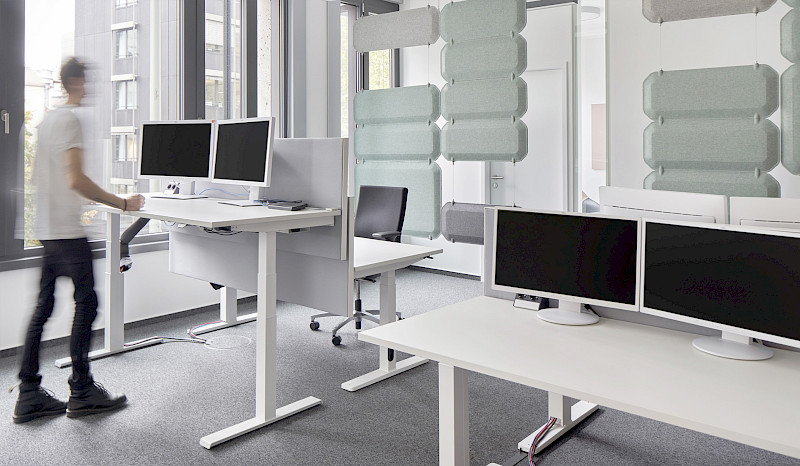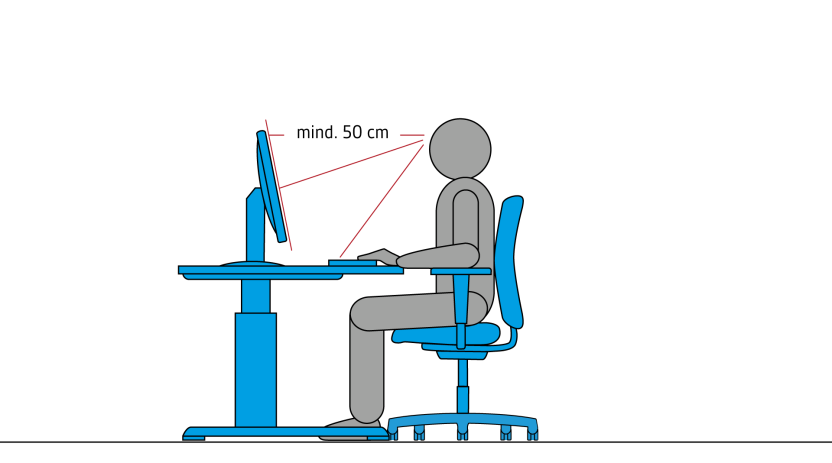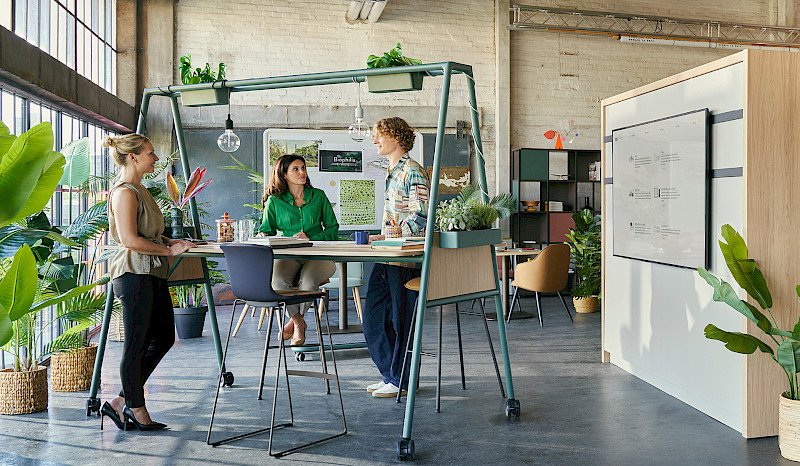Getting up occasionally and walking a few steps to the filing cabinet or kitchen can help stimulate your circulation. Below are some basic tips on how you can encourage more movement, reduce stress, and support your own health – or that of your employees.
Encouraging Movement
Often, simple measures are enough to promote more physical activity.
CREATING (SPATIAL) CONDITIONS
- Position printers outside of immediate reach.
- Store folders and documents away from the desk.
- Equip workstations with synchronised swivel chairs for dynamic sitting.
- Enable standing work – ideally with height-adjustable sit-stand desks.
- Provide informal communication areas away from workstations.

MAKING GOOD USE OF OPPORTUNITIES
- Stand while completing tasks where possible – such as phone calls, sorting papers, or jotting down creative ideas.
- For internal discussions, opt for face-to-face conversations, visit colleagues’ desks, or chat briefly while standing or walking past.
- Use different spaces consciously for different types of work.
Changing the office setup alone won’t automatically lead to increased movement. Integrating more activity into the working day takes getting used to. A useful reminder can be software that prompts people to stand up regularly. Many companies also train selected employees as ergonomics ambassadors who encourage standing meetings and help ensure workstations are properly adjusted to users’ needs.
Proper Workplace Adjustment
STEP 1: ADJUSTING THE OFFICE CHAIR
- Adjust seat height so that thighs and lower legs form a right angle.
- Set the backrest to provide optimal support to the lower back (lumbar area) when sitting upright.
- If possible, adjust seat depth and tilt. When adjusting seat depth, ensure a hand’s width of space between the seat edge and the back of the knee.
- Adjust armrest height so that elbows rest gently with shoulders relaxed, forming roughly a right angle between upper and lower arms.
- If available, adjust the headrest to support the head when leaning back.
- Adjust the synchro-mechanism’s resistance to match the user’s body weight.
STEP 2: ADJUSTING THE DESK
- First, position the keyboard on the desk, about 10–15 cm from the front edge. Some keyboards can be slightly angled – the tilt should not exceed 8°.
- Adjust desk height so that, when typing, the arms still form a right angle. Forearms and the back of the hands should form a straight line.
STEP 3: ADJUSTING THE MONITOR
- Place the monitor so that the distance between eyes and screen is at least 50 cm. Depending on the task, greater distances may be better. For safety reasons, make sure no part of the screen extends beyond the back edge of the desk.
- Tilt the monitor backwards by up to 35°.
- Set the screen height so the topmost line of text is at or just below eye level. A lower position is often preferable – especially for users of varifocal glasses.
If the desk cannot be adjusted in height, begin with step 2. Adjust the chair height to suit the fixed desk. The key reference point is the right angle between upper and lower arms. If the optimal seat height is too high for both feet to rest flat on the floor, a footrest must be provided.



Avoiding Stress
First, check whether the workload is appropriate and whether suitable resources are available to carry out the tasks. This includes not only the necessary knowledge and skills, but also appropriate tools such as a well-designed working environment and technical equipment. A well-thought-out workplace can make tasks easier and help reduce stress.
REDUCING NOISE
Employees most frequently report being disturbed by noise – especially by conversations.
- Ideally, spaces for communication and spaces for concentrated work should be separated.
- People who frequently switch between tasks need a well-shielded workplace.
- There should also be retreat areas available when needed – such as reservable private rooms, library-like lounges or so-called pods and room-in-room systems.

ENSURING PRIVACY
Retreat should be possible not only acoustically but visually. Partition walls or desk-mounted privacy screens can help. There is a wide range of shapes and materials to choose from. Examples can be found in the workplace showrooms at the IBA Forum.
CREATING A POSITIVE ATMOSPHERE
It’s obvious that the attractiveness of a space influences wellbeing. However, what a “pleasant atmosphere” looks like varies greatly from company to company and person to person. That’s why involving employees in the design of their workspaces is recommended.




